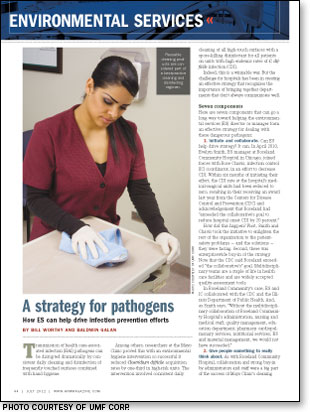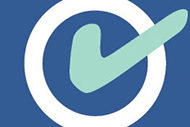 Transmission of health care-associated infection (HAI) pathogens can be disrupted dramatically by consistent daily cleaning and disinfection of frequently touched surfaces combined with hand hygiene.
Transmission of health care-associated infection (HAI) pathogens can be disrupted dramatically by consistent daily cleaning and disinfection of frequently touched surfaces combined with hand hygiene.
Among others, researchers at the Mayo Clinic proved this with an environmental hygiene intervention so successful it reduced Clostridium difficile acquisition rates by one-third in high-risk units. The intervention involved consistent daily cleaning of all high-touch surfaces with a spore-killing disinfectant for all patients on units with high endemic rates of C. difficile infection (CDI).
Indeed, this is a winnable war. But the challenge for hospitals has been in creating an effective strategy that recognizes the importance of bringing together departments that don't always communicate well.
Seven components
Here are seven components that can go a long way toward helping the environmental services (ES) director or manager form an effective strategy for dealing with these dangerous pathogens:
1. Initiate and collaborate. Can ES help drive strategy? It can. In April 2010, Evelyn Smith, ES manager at Roseland Community Hospital in Chicago, joined forces with Rose Chavis, infection control (IC) coordinator, in an effort to decrease CDI. Within six months of initiating their effort, the CDI rate at the hospital's medical-surgical units had been reduced to zero, resulting in their receiving an award last year from the Centers for Disease Control and Prevention (CDC) and acknowledgement that Roseland had "exceeded the collaborative's goal to reduce hospital onset CDI by 20 percent."
How did this happen? First, Smith and Chavis took the initiative to enlighten the rest of the organization to the patient-safety problems — and the solutions — they were facing. Second, there was enterprisewide buy-in of the strategy. Note that the CDC said Roseland exceeded "the collaborative's" goal. Multidisciplinary teams are a staple of life in health care facilities and are widely accepted quality-assessment tools.
In Roseland Community's case, ES and IC collaborated with the CDC and the Illinois Department of Public Health. And, as Smith says, "Without the multidisciplinary collaboration of Roseland Community Hospital's administration, nursing and medical staff, quality management, education department, pharmacy, cardiopulmonary services, nutritional services, ES and material management, we would not have succeeded."
2. Give people something to really think about. As with Roseland Community Hospital, collaboration and strong buy-in by administrators and staff were a big part of the success of Mayo Clinic's cleaning intervention. So, too, was communication.
In fact, in describing its intervention, Mayo's Robert Orenstein, D.O., says that despite the project's seeming simplicity, a great deal of communication was required. And while much has been written about putting together complex processes for communicating the importance of environmental hygiene to health care workers, the messages themselves are arguably as important.
To help drive the strategy in the battle against HAIs, ES should be the squeaky wheel — insisting that all messages strive to get attention and be more to the point, whether the communication is directed at doctors, nurses, staff, patients and their families or visitors.
For instance, ES managers may tell visitors: "C diff. is spread by the fecal-oral route, meaning that people swallow germs found in feces, often spread by people who did not wash their hands after using the toilet. Did you wash your hands?"
3. Create lists and check them twice. In his groundbreaking book, The Checklist Manifesto: How to Get Things Right, Atul Gawande, M.D., lays out the reasons why checklists are an absolute necessity to get things done right. Gawande cites physicians, surgeons, architects and pilots among the professionals who recognize that checklists are a requisite if they are to succeed and perform safely.
Likewise, checklists should be mandatory tools for every ES department if disrupting the transmission of emerging HAI pathogens is the goal. Staff should use them — one checklist per room — in their daily duties. Supervisors or inspectors should use them to document a staff member's completion of an assignment.
Checklists also can be used by members of a multidisciplinary team specifically tasked with checking on the quality of cleaning and disinfection of patient rooms.
Examples of ES checklists are available online from a variety of sources. For instance, the CDC (www.cdc.gov) provides a toolkit containing several environmental cleaning checklists at its website; the Association for the Healthcare Environment (www.ahe.org) also features checklist materials on its site; and Joint Commission Resources (www.jcrinc.com) includes sample checklists among its best practices gathered from health care organizations across the country.
Additionally, some hospitals have published online comprehensive policies and procedures for environmental cleaning, including one for emerging infectious diseases (though that site states that use is restricted without permission).
The fact is, checklists need not be elaborate, but they must be sufficient enough in detail that a staff member has no question about what is expected of him or her, and they need to address all areas that a patient or caregiver may touch or surfaces upon which HAI-causing pathogens are likely to be found.
The bigger fact is, checklists work. Gawande says they work because they document each step in a given procedure as a reminder to busy hospital personnel who may overlook a step when doing many things at once in a taxing, unpredictable work environment. Second, lists instill a sense of responsibility among the people performing a task or procedure, in that everyone is responsible for the success of the whole, including ES.
4. Focus on contact points. Focus on patient contact points, also commonly called high-touch points.
It's true that shiny floors make a good first impression and they are an important part of the public perception of a hospital. However, they have little to do with HAI prevention.
It's important to keep in mind that, although first impressions are important, last impressions are lasting. Patients who contract an HAI will remember the HAI much longer than they will remember shiny floors.
5. Eliminate cross-contamination. Cross-contamination happens more often than is realized. Health care professionals have recognized this and have put many resources into efforts to get everyone to wash or sanitize their hands before, during and after patient encounters.
However, they also must connect the dots when it comes to answering the question: "Where do the pathogens that are transmitted to hands and patients come from?" Yes, they do come from the bodies of patients and staff. But they also come from the care environment.
So, what's the solution? The ES strategy should ensure that best practices are utilized to eliminate cross-contamination. Color-coded products combined with a one-per-room methodology helps to limit, if not eliminate, cross-contamination and are used for defined tasks — one color for patient bathroom cleaning and disinfecting and another color for the remainder of the patient room.
Reusable cleaning products are considered part of a best-practice cleaning and disinfecting regimen. They should be laundered in accordance with the CDC guidelines for bloodborne pathogens and aligned with the American Hospital Association's Sustainability Roadmap.
6. Read the fine print. Recently, a product that was supposed to be a hospital-grade disinfectant was ordered off the market by the Environmental Protection Agency because the claims proved to be inaccurate.
ES managers and directors have a responsibility to make sure the products used in their facilities actually support effective infection prevention. Many don't and equally as many contribute nothing to sustainability.
Directors and managers must dig below the surface hyperbole of manufacturer claims by asking for independent lab testing results. They must ask the tough questions of cleaning product manufacturers.
But how is one to know what questions to ask? Be informed, stay abreast of information provided in relevant professional and trade journals, and look beyond the hospital walls for answers to best practices in other facilities.
In simple terms: If a product sounds too good to be true, ask for independent verification. Learn to read between the lines. For example, a manufacturer can produce slick multipage copy to garner attention, but when one gets right down to the only significant selling point, it may be that the only key product feature is that the container keeps out air.
For an effective ES strategy to battle emerging pathogens, staff must be trained to know when to dig below the surface claims of products. Too often, cost is the greatest motivating factor in a purchase when it should be the least. Efficacy, safety and cost are involved; they all are important, but they should be prioritized in that order.
7. Insist that it's about time. Times and finances have changed. Most hospitals and ES departments are working on reduced budgets. There are a few exceptions, but too many ES departments are so strapped for staff they have had to resort to a "trash-and-dash" operation rather than adhere to standards for proper cleaning and disinfection.
A trash-and-dash mentality literally means ES is charged with emptying the trash and that's about it. This is no way to deal with emerging pathogens.
Nurses cannot hurry up an IV at the risk of patient injury or death. Surgeons cannot perform a surgery in one hour if proper, safe procedures dictate four hours. By the same token, ES should not be placed under unrealistic time constraints. They are working to eliminate HAI-causing pathogens from the patient care environment.
Every discipline has time constraints, but every discipline has time guidelines to ensure a successful outcome. For instance, there are published recommended minimum times for cleaning occupied and discharged patient rooms
When viewed from a common eight-hour day, an ES staffer assigned to patient rooms can properly clean and disinfect a maximum of 10 discharged patient rooms per day, not taking into account breaks and travel time involved in ancillary tasks.
A winnable fight
The fight against HAI pathogens is, indeed, a long, resource-intensive and continuous one. But, with the right coordination, tools and time, it is a battle that is ultimately winnable.
Bill Worthy and Baldwin Galan are product specialist managers with UMF Corp., Skokie, Ill. They can be reached at BWorthy@perfectclean.com and BGalan@perfectclean.com, respectively.
| Sidebar - How ES can help hospitals raise their HCAHPS scores |
| Can environmental services (ES) departments help hospitals raise their Hospital Consumer Assessment of Healthcare Providers and Systems (HCAHPS) survey scores? Definitely. Beginning in November, the Centers for Medicare & Medicaid Services will be rewarding hospitals for quality based on these scores. The scores capture patients' perspectives of their hospital care, including cleanliness of the hospital environment. Administrators at a large hospital in upstate South Carolina recently noted a "dramatic increase" in relevant HCAHPS patient satisfaction scores — from the 23rd to the 92nd percentile — since the implementation last September of an ES departmentwide training program. The hospital's new program comprises training components that include (in all patient rooms and all other areas of the hospital):
The hospital's new program also reinforces the significance of combining environmental and hand-hygiene initiatives; and it underscores why infection prevention needs to be an organizational priority. More than 130 members of the hospital's ES staff participated in the training program. "I'm confident this new initiative in our approach to environmental hygiene has had a significant role in the improving numbers," one administrator says. "Already, our patients have indicated they've noticed a difference in the hospital's approach to hygiene." |
| Sidebar - For more information, go to the sources |
| Need more information on preventing health care-associated infection pathogens? The following resources were used by the authors in the
|





